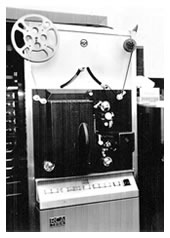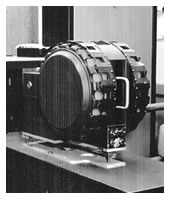One of a Kind | The Film Room
Not to be confused with the Projection Room, where films were televised, in the film room reels of 16mm film were prepared for projection. We use the past tense "was," for, as far as we know, film is no longer used at broadcast stations. Everything now is digital.
 Film editor Bob Carter - Credit: Don McDaniel
Film editor Bob Carter - Credit: Don McDaniel
Back in the day ( in this case the late '50s and into the'60s), the Film Room was a small upstairs space, about the size of a walk-in closet. If was just deep enough for a counter along one wall, at which, on a pair of "rewinds," the editor inspected reels of film; and a tall stand for a 16mm projector. At one end was a dumbwaiter, in which boxed films could be moved to and from the Projection Room downstairs.
TV stations lease movies in packages, each package having dozens of feature films with pre-specified air dates. The pictures were bicycled from station to station, as were syndicated shows. A few days prior to a title's air date, a 16mm print arrived at WBTV. The film editor inspected the film for damages, and projected it on the wall, to see that all the scenes were in proper order.
He would then splice a 3-foot section of white opaque leader in places where commercials were called for.
(As the movie aired, the projectionist watched for the white leader to come around and off the feed reel. Then, in one quick action, he would shut down the projector and switch to another device, a videotape machine or another projector, thus beginning a sequence of commercials. During this brief interlude, the projectionist cued up the film for the next segment.)
After the film aired, the reel was sent back up to the editor, who took out the white leader, re-spliced the print to its original condition, and sent it down to shipping, where it would be "bicycled" to the next TV station.
Over the course of the leasing contract, WBTV might schedule the film multiple times, spaced months apart. So the editor would handle the film (but not necessarily the same print) again and again.
Reg Dixon, who replaced Bob Carter, remembers:
Over the three years I was film editor I must have screened every movie from The Jazz Singer to The Longest Day. The purpose of screenings was to discover (and remove) over-the-top adult scenes and profanity, and find appropriate places to cut in those lengths of opaque leader.
The liquid film cleaner I used had a special "heady" aroma that would make one a little dizzy while running the film through a cleaner pad. Leslie Wright, one of the TV Sales Department secretaries, would pop in from time to time to watch Fred Astaire and the Ginger Rogers musicals. I still watch them. And Laurel & Hardy. I still have a 16mm projector stuck in a closet—but no film.
Before my stint as film editor, I was a projectionist (in “the room that made the money,” as I was told—too bad the salary didn't meet the responsibility!) Early on, engineers (trained in broadcast electronics) operated the projection equipment, but later turned it over to mere ‘civilians’ like me. Other fellows who worked in there after the engineers gave it up were Charlie Lineburger, Gil Caldwell, Bob Storck, et al.




 Film editor Bob Carter - Credit: Don McDaniel
Film editor Bob Carter - Credit: Don McDaniel